From the Designers’ Desks: Abby Goldstein and Paul Shaw
Revival Type: Digital Typefaces Inspired by the Past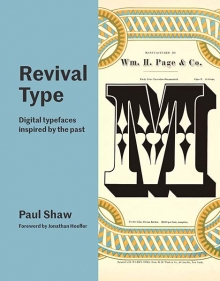 From the Designers’ Desks: Abby Goldstein and Paul Shaw is a new book that provides a fascinating, visually rich tour through typographic history. The book is the result of a close collaboration between Abby Goldstein and Paul Shaw that does not fit neatly into the usual author/designer paradigm. Their thoughtful and illuminating answers to our questions from the blog series From the Designer’s Desk, combined here, reflect their intertwined method of working on books together.
From the Designers’ Desks: Abby Goldstein and Paul Shaw is a new book that provides a fascinating, visually rich tour through typographic history. The book is the result of a close collaboration between Abby Goldstein and Paul Shaw that does not fit neatly into the usual author/designer paradigm. Their thoughtful and illuminating answers to our questions from the blog series From the Designer’s Desk, combined here, reflect their intertwined method of working on books together.
Why did you pursue design, rather than, say, painting or architecture or sculpture?
Abby: I studied fine art and design at Pratt Institute. Their foundation course, based on the Bauhaus, is what drew me there. I fell in love with typography and design during my last year of college and collected books on the subject, and still do. From this passion I began my studies in graphic design in earnest, turning it into a practice. I am constantly learning. Ultimately, I see myself as both an artist and designer.
Paul: I pursued design by accident. I am educated as an historian. But I always drew letters when I was young and when I was a graduate student at Columbia University I began doing calligraphy commercially to help pay my way through school. Soon, I began to teach myself typography and layout. The next thing I knew I had a solo design practice focusing on lettering and I had abandoned my dissertation. I never gave any thought to painting, sculpture, or architecture.
Have you ever completed a project and only after the book was printed did the perfect (or, at least, a better) design solution occur to you?
Abby: I have the “I am my own worst critic” syndrome. I am never satisfied and inevitably find something I feel I could have improved. Should that .25 rule have been .5 or the spacing below a head be just a little less or more space? Maybe there should have been a bit more or less kerning around a display head? Is the color too warm or too cool? What I love about designing is the collaborative process; if my client is happy then the little things that bother me become less annoying.
Paul: Only once. I wrote the text for a small book on the German calligrapher Werner Schneider that was designed and produced by my friend Michael Clark. I had no part in the design and wish I had. The book is oblong but half of the designs shown are vertical and thus do not fit comfortably on the page. The other half are horizontal and do work well. But I feel there must be a format that could better accommodate both types of artwork.
Is your work on a book project usually more of a slow, progressive effort, or is it moved forward by unpredictable moments of inspiration?
Paul: Both. I start out slow, gathering material, thinking about the topic and how best it should be visually displayed. But once I finally dig into the book, it can move ahead in spurts. They are not due to unpredictable moments of inspiration but just to the momentum of an idea finally coming to fruition. As a book progresses there are moments of intuition where I, or my frequent collaborator Abby Goldstein, realize that there is a better way to do things. That often entails tearing down part of what has already been done and starting over.
Abby: Most of the design projects I work on have tight deadlines and the initial meeting with the client is often the most informative and inspirational. Collaborating with Paul is all about slow design. We have known each other for over 30 years. We began working on a book about the roots of type in 2008. We met every Friday for a few years, researching, planning, debating while we listen to jazz and took short breaks for delicious lunches. I learned to accept and appreciate Paul’s thoroughness and commitment not to rush through the process. Design, research and development are done all together and content is not separated out until the very end when Paul goes off to write the text and I clean up the files.
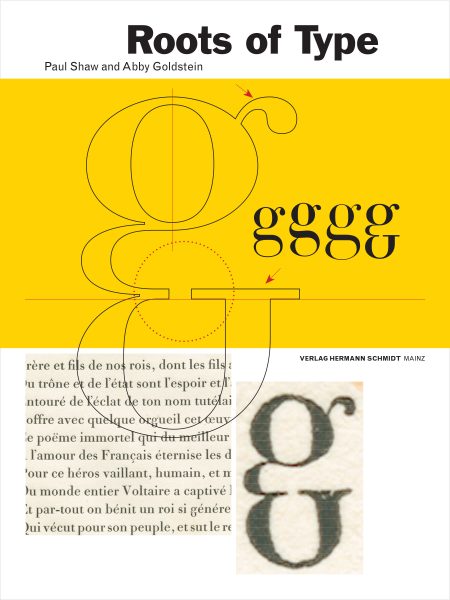
Cover for The Roots of Type, a book on the historical origins of contemporary typefaces proposed for Verlag Schmidt in 2007. The book was never completed, but it became the source of much of Revival Type.
Do you feel that a book’s design can, or even should, play an assertive role in how a reader experiences the book, or do you feel the best book design is a kind of behind-the-scenes art – where the reader isn’t even always aware of the influence of the design?
Abby: I love the collaborative nature of book design. To work with an author, editor, another designer, or artist in bringing their words and vision into a visual form is incredibly rewarding. My mentor, Betty Binns, came to design with a background in mathematics and philosophy. She taught me that a book design should compliment and enhance the content and not distract the reader. Although, I do admire the work of designers who ignore these design precepts and come up with startling and challenging book designs.
Paul: I often believe in Beatrice Warde’s concept of the Crystal Goblet in which the design and typography of a book should not interfere with the meeting of author and reader. But that said, design and typography can subtly enhance that experience; can improve the understanding of a text. This is especially true for books that have a visual component, whether they are about architecture or science or demographics. My mantra is that design should be derived from content and context. It should not be imposed from without on a text. With Helvetica and the New York Subway System, Abby and I succeeded in seamlessly tying together the images and notes with the text so that the reader did not have to flip pages to find things. That is something that most readers don’t consciously notice, but several have commented on how pleasant that has been for them. For Revival Type, Abby and I made an effort to keep each typeface being profiled on either a single spread or double spread rather than to just let the text flow in the normal manner with sections always starting on the recto. We decided to violate the traditions of book design and start on the verso. That is not always obvious as we disguised things with full-page bleed images on the verso of each chapter.
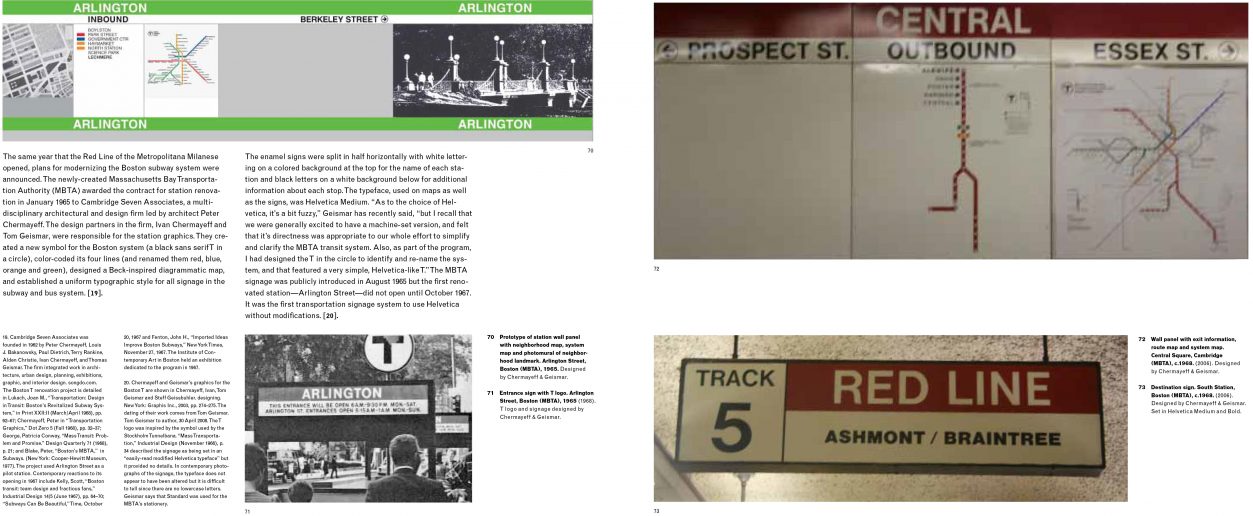
Spread from Helvetica and the New York City Subway Systems (The MIT Press, 2010). The book’s design is notable for the integration of all photographs and notes referring to a text on the same spread. The reader does not have to turn pages to see an image referred to in the text or look up the source of a statement.
What is your favorite font?
Abby: There were fewer choices before computers. I prided myself in knowing them all—no longer. I had a short stint as a book jacket designer at Doubleday back in the early 1980s and we would have a contest to see who could use the latest designed typeface on a book cover. As a book designer, I relied on a few more than Massimo Vignelli’s famous five: Bodoni, Bembo, Electra, Dante, Futura, Gill Sans, Univers, Frutiger, Century Schoolbook were my go-to choices. Once I went digital I often would use Scala and Scala Sans by Martin Majoor, Adobe Caslon by Carol Twombly, and Adobe Garamond by Robert Slimbach. I am particularly fond of PMN Caecilia by Peter Matthias Noordzij. I admire Neue Haas Grotesk by Christian Schwartz and Classic Grotesque by Rod McDonald. My default type for students is Akzidenz-Grotesk. Students gravitate towards Minion and Avenir because of the ease of access. There are so many exceptional typefaces being created today it is impossible to pick just one. I hope Revival Type, as a reference book of digital types and their historic roots, will help students and designers make better-informed type choices.
Paul: I don’t have one, but my default working font for documents is Frutiger Light and my official font for my design business has been Trump Medieval since 1980. (No connection to the current occupant of the White House, thankfully.)
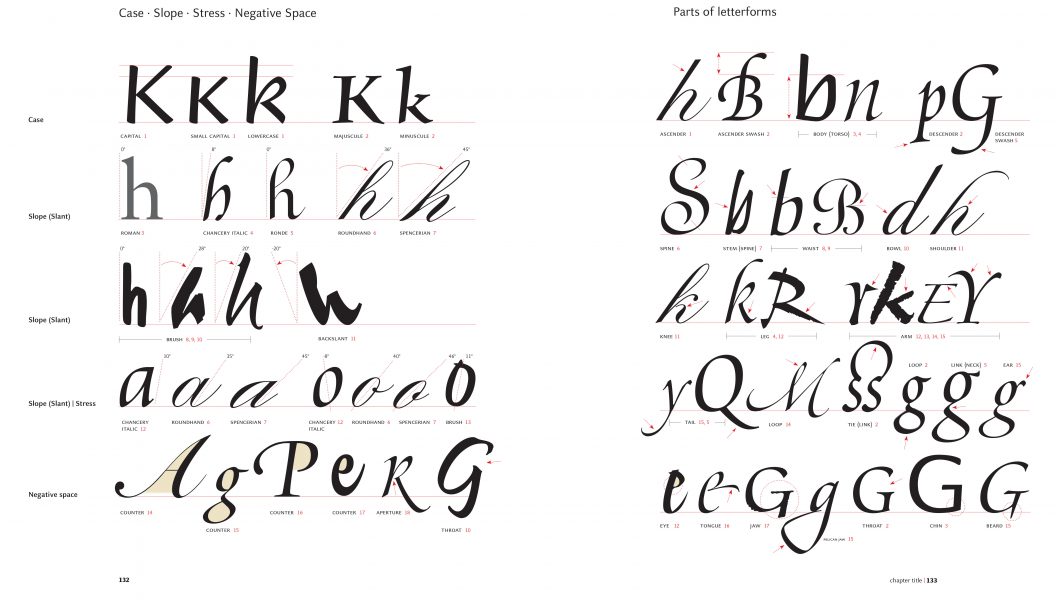
Spread from The Roots of Scripts, a spin-off project from The Roots of Type that is still in progress. The complex diagram shown here is the forerunner of the one in Revival Type. Its content represents a close collaboration between author and designer.
Do you design books in other genres and categories than art and architecture? If so, what are some primary differences between designing, say, a novel versus a large, glossy book on architecture?
Abby: I have designed every kind of book over the past three decades. Though I have specialized more in art and architecture books for museums, galleries and publishers. I learned the nuances of designing hierarchy, consistency, and attention to the smallest typographic detail from Betty and our work on textbooks. She always referred to Malcolm Grear’s elegantly designed biology book as the gold standard in textbook design. I believe this approach works for all books.
Paul: I am not a book designer. I am a graphic designer and design historian. In recent years I have tried to work with friends who are book designers to ensure that the points I am trying to make in the texts I have written are as well explained as possible. I have collaborated closely with Abby and Linda Florio, both of whom bring not only a book designer’s experience to my projects but also a painter’s eye. One of the things that separates a book designer from a graphic designer—at least the good ones like Abby and Linda—is an awareness that a book is not just a collection of single pages to be designed like mini posters, but a series of pages that need to be organized and orchestrated in the manner of a film or musical composition. A good book (or magazine such Codex on which Linda and I worked together) needs to have a visual flow that pays close attention to pacing and sequence. Achieving that can only happen when author and designer work closely together.
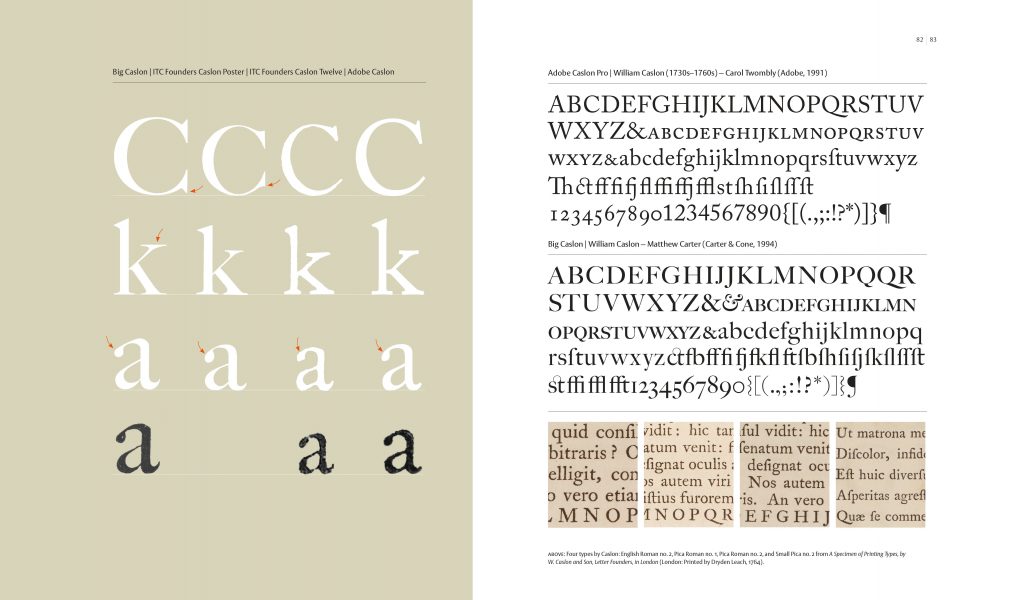
Spread from Revival Type showing the diverse mix of elements (type specimens, diagrams, close-ups) that characterize the book.
How can an author make a book designer’s job easier?
Paul: By being organized in advance. Or at least that is what Linda always tells me. But I find that that is not entirely possible, that my thinking about the visual presentation of my texts evolves as I work with a book designer. One of the things I enjoy about working with Abby is her openness to that process. Even if the text of a book is entirely mine, its final form owes much to my interaction with the book’s designer.
Abby: A very neat and tidy document prepared with images clearly marked is ideal. However, it rarely happens. I find the first real meeting with a client is often the best place to discuss preparation of the text document and a good place to get a jump-start on checking and preparing the images. Linda Florio is to be thanked in getting Paul to be a little more prepared in advance.
Who are your favorite book designers?
Abby: Jan Tschichold, Jost Hochuli, Bruce Rogers… and I have to list Quentin Fiore’s design for Marshall McLuhan’s The Medium is the Massage as a favorite. Contemporary designers, Irma Boom, J. Abbott Miller, and Linda Florio have produced some extraordinary book designs. I have always admired the work of Cheryl Towler Weese, Studio Blue. Their books are always elegant with a special unique touch to them.
Paul: Jan Tschichold, Jost Hochuli, Hans Schmoller, and Hans Rudolf Bosshard. They are masters of typography and layout. But none of them handle text and image with the sophistication and sympathy that I have come to expect from both Linda and Abby.
Abby Goldstein is a designer and artist. She is an associate professor of art and heads the graphic design concentration at Fordham University. Paul Shaw is a graphic designer and design historian. He teaches at Parsons School of Design, the School of Visual Arts, and the California Rare Book School.























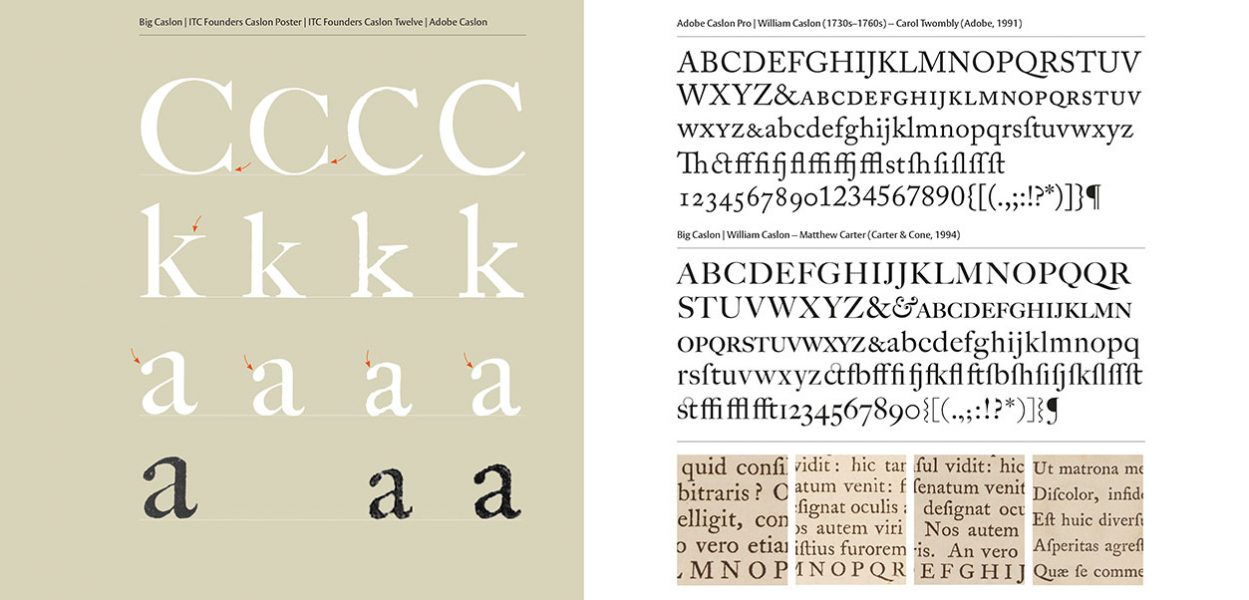
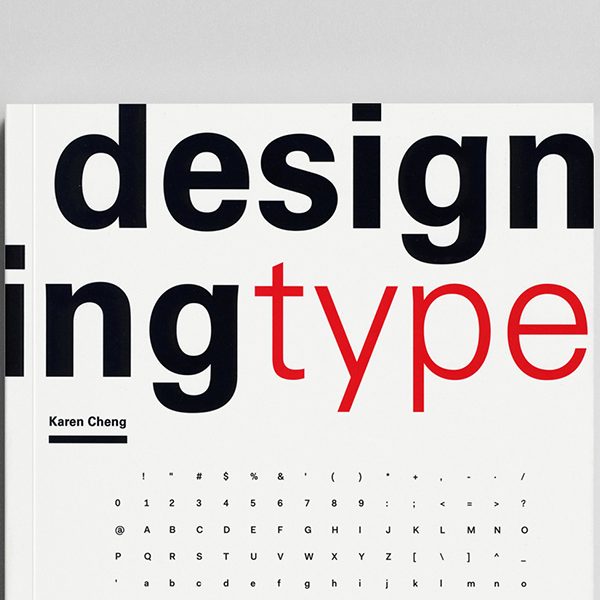
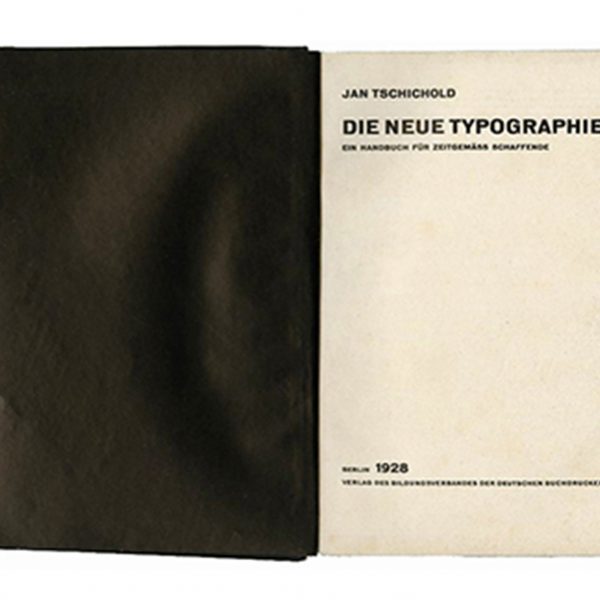

I see a very elegant (and slightly humorous) season’s greetings card that serves to educate as well as entertain. Design by Paul Shaw and Abby Goldstein. May I have a Coca-Cola typeface design?